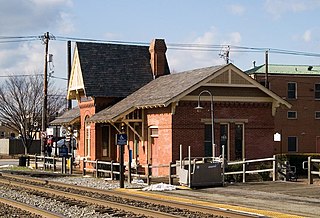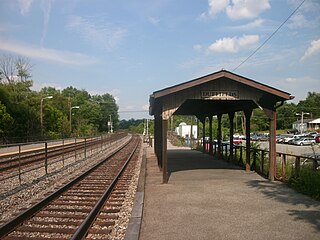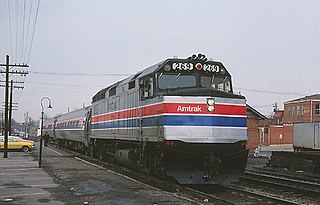
The Capitol Limited is a temporarily discontinued daily Amtrak train between Washington, D.C., and Chicago, running 764 miles (1,230 km) via Pittsburgh and Cleveland. Service began in 1981. On November 10, 2024, Amtrak temporarily combined the Capitol Limited and Silver Star, producing a Chicago-Washington–Miami route, the Floridian.

The Maryland Area Rail Commuter (MARC) is a commuter rail system in the Washington–Baltimore area. MARC is administered by the Maryland Transit Administration (MTA) and operated under contract by Alstom and Amtrak on track owned by CSX Transportation (CSXT) and Amtrak. In 2023, the system had a ridership of 3,860,600, or about 13,900 per weekday as of the third quarter of 2024, less than pre-COVID-19 pandemic weekday ridership of 40,000.

Rockville station is an intermodal train station located in downtown Rockville, Maryland, United States. It is served by the Washington Metro Red Line, MARC Brunswick Line commuter trains, and Amtrak Floridian intercity trains.

West Baltimore station is a commuter rail station located in the western part Baltimore, Maryland, along the Northeast Corridor. It is served by MARC Penn Line trains. The station is positioned on an elevated grade at 400 Smallwood Street near parallel West Mulberry and West Franklin Streets extending off U.S. Route 40. Three large surface lots are available for commuters. The station only has staircases from street level and two low-level side platforms next to the outer tracks and is thus not accessible to people with some mobility disabilities, but MTA Maryland plans to renovate the station with accessible platforms and entrances.

The Brunswick Line is a MARC commuter rail line between Washington, D.C., and Martinsburg, West Virginia, with a branch to Frederick, Maryland. It primarily serves the northern and western suburbs of Washington. The line, MARC's second longest at 74 miles, is operated under contract to MARC by Alstom and runs on CSX-owned track, including the Metropolitan, Old Main Line, and Cumberland subdivisions. It is the successor to commuter services provided by the Baltimore and Ohio Railroad (B&O), which date to the mid-19th century.

The CSX Cumberland Subdivision is a railroad line owned and operated by CSX Transportation in the U.S. states of Maryland and West Virginia. The line runs from Brunswick, Maryland, west to Cumberland, Maryland, along the old Baltimore and Ohio Rail Road (B&O) main line. At its east end, the Cumberland Subdivision becomes the Metropolitan Subdivision; at its west end at Cumberland, Maryland it becomes the Cumberland Terminal Subdivision. It meets the Shenandoah Subdivision at Harpers Ferry, West Virginia, and the Lurgan Subdivision in Cherry Run, West Virginia.

Harpers Ferry station is a railway station in Harpers Ferry, West Virginia. It is served by the Amtrak Floridian intercity service as well as MARC Brunswick Line commuter service. The station is listed on the National Register of Historic Places as part of the Harpers Ferry Historic District. It has two side platforms serving the two tracks of the CSX Cumberland Subdivision. The station is not accessible.

Martinsburg station is a railway station in Martinsburg, West Virginia, United States, served by MARC Brunswick Line commuter rail service and Amtrak Floridian intercity rail service. The station has one side platform serving a siding track of the CSX Cumberland Subdivision, with a footbridge crossing the siding and the two main tracks to provide access to the preserved Baltimore and Ohio Railroad Martinsburg Shops complex.

Perryville station is a passenger rail station on the Northeast Corridor in Perryville, Maryland. It is the northern terminus of the MARC Penn Line. The station has a single side platform serving the northern track of the four-track Northeast Corridor. The station building houses the Perryville Railroad Museum, which includes a model train layout and exhibits about the history of railroads in Perryville.

Gaithersburg station is a commuter rail station located on the Metropolitan Subdivision in downtown Gaithersburg, Maryland. It is served by the MARC Brunswick Line service; it was also served by Amtrak from 1971 to 1986. The former Baltimore and Ohio Railroad station building and freight shed, designed by Ephraim Francis Baldwin and built in 1884, are listed on the National Register of Historic Places as Gaithersburg B & O Railroad Station and Freight Shed. They are used as the Gaithersburg Community Museum.

Barnesville is an active commuter railroad train station in Barnesville, Montgomery County, Maryland. Located on Beallsville Road, Barnesville station services trains of MARC Train's Brunswick Line between Union Station in Washington D.C. and Martinsburg, West Virginia. Additional trains operate to Frederick, Maryland. Amtrak's Capitol Limited operates through the station, but does not make any stops. The next station west is Dickerson while the next station east is Boyds. Barnesville station contains two low-level side platforms, connected by a pathway across the tracks.

Brunswick is a passenger rail station on the MARC Brunswick Line between Washington, D.C., and Martinsburg, West Virginia. The station house, located at 100 South Maple Street in Brunswick, Maryland, is a former Baltimore and Ohio Railroad depot that is a contributing property to the Brunswick Historic District, which has been listed on the National Register of Historic Places since August 29, 1979. The station was designed by Ephraim Francis Baldwin and opened in 1891 on Seventh Avenue. Several years later the building was moved to its current location. It is a wooden frame building with stone walls up to the window sills, and features Palladian windows in the roof dormers.

Duffields is a passenger rail station on MARC Train's Brunswick Line, in the community of Duffields, West Virginia. Since it is located in West Virginia, the station is maintained by the West Virginia State Rail Authority rather than by MARC itself. Between 1976 and 1981 this station was served by Amtrak's Shenandoah which traveled between Washington and Cincinnati.

The Bowie Railroad Buildings comprise three small frame structures at the former Bowie train station, located at the junction of what is now the Northeast Corridor and the Pope's Creek Subdivision in the town center of Bowie, Maryland. The complex includes a single-story freight depot, a two-story interlocking tower, and an open passenger shed. The station was served by passenger trains from 1872 until 1989, when it was replaced by Bowie State station nearby. The buildings were restored in 1992 as the Bowie Railroad Museum and added to the National Register of Historic Places in 1998.

Silver Spring station is a former train station on the Metropolitan Subdivision in Silver Spring in Montgomery County, Maryland. It was built in 1945 by the Baltimore and Ohio Railroad on the foundation of a previous station, a Victorian-style brick structure built in 1878. It served intercity trains until 1986 and commuter rail until 2000. Today, it is owned and operated as a museum by Montgomery Preservation, Inc., a non-profit organization.

The West Virginian, later known as the Potomac Turbo and Potomac Special, was a daily passenger train operated by Amtrak between Washington, D.C., and Parkersburg, West Virginia. This route was previously served by the Baltimore & Ohio's (B&O) train of the same name, and was the first of several services in the state of West Virginia established at the behest of US Representative Harley Orrin Staggers, the powerful chair of the House Interstate and Foreign Commerce Committee. This patronage earned the train the derisive sobriquets "Harley's Hornet" and the "Staggers Special".

The Shenandoah was a daily passenger train operated by Amtrak between Washington and Cincinnati from 1976 until 1981.

The Colonial was an Amtrak intercity passenger train that operated between Boston, Massachusetts, and Newport News, Virginia, from 1976 to 1992. It was introduced on June 15, 1976, to replace the lightly-used Charlottesville-Newport News section of the James Whitcomb Riley. Certain trips were known as the Senator and Tidewater beginning in the late 1970s. The Richmond-New York City Virginian was added in 1984, with some trips called Potomac from 1985 to 1988.


















